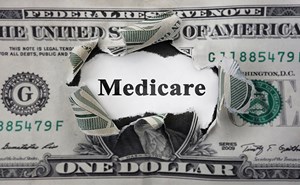Many of you are all too aware of the annual song and dance the physician community has to do with Congress to avoid significant reductions to Medicare physician payments. As I noted in a previous blog post, Congress stepped in at the end of last year to offset 3 percent of a scheduled 3.75 percent reduction to the Medicare physician fee schedule (PFS) in 2022. However, that was only a one-year fix, and without additional Congressional action, the 3 percent cut to the PFS will pop back up in 2023. Beyond the PFS, there are also automatic across-the-board reductions, called sequestration, that we have to worry about. Starting in April, the Medicare sequester (which has been temporarily halted during the pandemic) will phase back in. It will begin as a 1 percent cut to all Medicare payments, and then it will grow to 2 percent starting in July. There is no end in sight to the 2 percent Medicare sequester. It is scheduled to last until 2030, and it could easily be extended beyond that. Finally, come 2023, there is the risk that an additional sequester of up to 4 percent could be triggered. That “pay-go” sequester was also delayed by Congress, but it could rear its ugly head unless Congress acts again.
All in all, Medicare physician payments are a mess. Instead of reliable updates to physician payments each year that keep up with inflation (which you all deserve), we have to beg and plead to just to keep payments flat. While permanent reform is necessary, Congress only seems to want to institute one-year fixes, kicking the can down the road each year. ACEP recently signed onto a letter from nearly the entire physician community asking Congress to take on this challenge this year and, at-long-last, work toward a long-term solution that provides stability for physician payments.
As we go through the song and dance again this year, things could be different—and there may be a glimpse of hope for a longer-term fix. Why is that? It’s not only because the physician community is united in its effort to advocate for reform—but we also just found out that we could have a new dancing partner. The Secretary of the U.S. Department of Health and Human Services (HHS), Xavier Becerra, recently stated that HHS may be willing to actually help out and work on a permanent solution with Congress. In an interview, Secretary Becerra (who is a former member of Congress) said "I remember those cliffs when I was in Congress; we always have to deal with those, and you'd never want professionals… thinking that there may be a different profession for them down the line because they're just not making ends meet where they are."
Now, some of you may be wondering what steps HHS can actually take to help Congress develop a permanent solution. HHS does routinely provide technical and legal assistance to Congress on potential legislation, but only has a few opportunities each year to present Congress with full-fledged legislative proposals. One of those opportunities is coming up—the annual President’s Budget—which may be released next Monday, March 28. In the President’s Budget, the White House not only includes specific funding requests for each federal agency, but also lays out its policy priorities and its ideas for reforming federal programs like Medicare and Medicaid. Including a proposal in the President’s Budget that presents a permanent solution to the broken Medicare physician payment system would be an excellent way of showing Congress that this Administration is serious about reform.
We will have to wait and see whether such a proposal is in the President’s Budget. But even if it is, we are still facing a significant uphill battle for Congress to actually act. The biggest impediment is the cost of any legislation that would provide permanent inflationary updates to physician payments. Although facilities get market-basket updates and private plans get large increases to their Medicare payments each year, unfortunately, under “current law,” physicians and other clinicians don’t. The Medicare Access and CHIP Reauthorization Act (MACRA), passed in 2015, set the schedule for payment updates in the long term. From now until 2026, the Medicare PFS update is zero percent each year, and then going forward, the updates are extremely small (0.25 percent or 0.75 percent depending on where physicians participate in certain alternative payment models). On top of the MACRA updates (or lack thereof) is the issue of “budget neutrality” in the PFS. Every year, the Centers for Medicare & Medicaid Services (CMS) re-evaluates and changes the values of specific PFS codes. By law, if those code revisions would result in a change in Medicare expenditures of greater than $20 million (which they usually do), CMS must make an overall adjustment to Medicare physician payments to keep overall spending from increasing. This budget neutrality rule is why the PFS is facing an expected 3 percent reduction in 2023. Modifying “current law” by increasing the payment updates set by MACRA and/or by eliminating the PFS budget neutrality rule would have significant spending implications, costing tens if not hundreds of billions of dollars over the ten-year budget window in which Congress operates.
Another impediment is the appetite of Congress to work on another overhaul of physician payments. MACRA was supposed to be the solution. It repealed the flawed sustainable growth rate (SGR) formula and created a new Medicare performance program called the Quality Payment Program that was designed to improve quality and reduce overall health care costs. However, the policies and programs created in MACRA have not proven to be the panacea that we all hoped they would be. In fact, CMS’ own actuaries predicted in the 2021 Medicare Trustees Report that Medicare physician payments will eventually be lower under current law than they would have been if the SGR had still been in place!
As far as a MACRA fix is concerned, keep in mind that the SGR was in effect for nearly two decades. It took years to develop MACRA, and it was passed by Congress thanks to a rare combination of fortunate timing and significant political will. It could be extremely difficult, and potentially risky, for Congress to start another process to come up with yet another solution—a solution which also ultimately could turn out to be both expensive and unsuccessful.
Finally, there are some strong voices telling Congress that physicians are doing just fine and don’t need any higher payment updates than they receive under current law. Last week, the Medicare Payment Advisory Commission (MedPAC) released an annual Report to Congress that includes recommendations on Medicare payment rates for physicians and other clinicians and hospitals and all other facilities. In the report, MedPAC recommends that physicians should receive the zero percent update in 2023 that is scheduled under current law. MedPAC conducted an analysis that determined that “Medicare’s aggregate payments for physician and clinician services are adequate.” MedPAC stated that “although clinicians have experienced declines in their Medicare service volume and revenue due to the pandemic, the Congress has provided tens of billions of dollars in relief funds to clinicians” and MedPAC expects that “volume and revenue to rebound to pre-pandemic levels (or higher) by 2023.”
This recommendation is extremely disappointing, but it is expected. In public meetings that occurred in December 2021 and January 2022, the MedPAC Commissioners debated and approved this recommendation. After the December 2021 meeting, ACEP sent a letter to MedPAC opposing the recommendation and asking the Commission to reconsider. We stated that we strongly believe that a zero percent update to physician reimbursement in 2023 is artificially low and does not nearly cover the increased cost due to inflation of providing care to Medicare beneficiaries. We urged MedPAC to instead recommend to Congress that the PFS be updated by an inflationary factor, such as the Medicare Economic Index—which has been used for decades to measure the annual changes in physicians' operating costs and earnings levels. Obviously, MedPAC chose not to adopt our suggestion and instead went forward with its flawed recommendation.
It is important to note that all of MedPAC’s recommendations are NOT binding. However, it certainly doesn’t help for an independent advisory body to be telling Congress that it would be just fine if Congress chose not to act. Legislators now have an excuse they can point to if they decide to punt again.
While the chances of long-term reform still aren’t great, we now at least have a chance to see how good a dancing partner Secretary Becerra can be. Will he be an effective advocate and tell CMS to work with Congress on potential solutions? Will he present proposals that save money to Congress that would help offset the cost of reform? Will he be willing to negotiate with Congress and put in the hard work that is needed to help get any reform past the finish line? It remains to be seen how active a role Secretary Becerra and his Department will play-- but he may be our best hope.
Until next week, this is Jeffrey saying, enjoy reading regs with your eggs!






